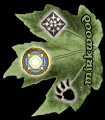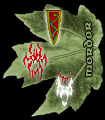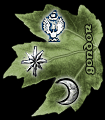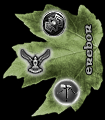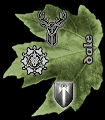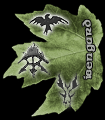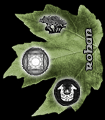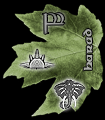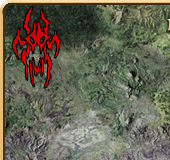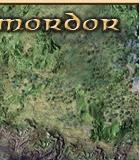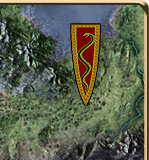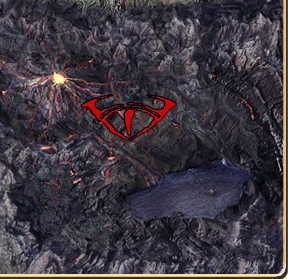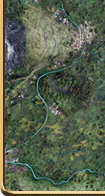|
Mordor was the realm of the Dark Lord Sauron. It was a terrible land of darkness and fear, inhabited by Orcs and other evil creatures. High mountain ranges on three sides formed a nearly impenetrable defense around Mordor. But during the War of the Ring, two Hobbits entered Mordor to destroy the One Ring in Mount Doom, and much of the land was laid to waste and its evil inhabitants - including Sauron - perished. Location Mordor was located along the lower course of the Anduin, on the eastern side of the river. The land of Rhun was east of Mordor, Khand was to the southeast, and Harad was to the south. On the western side, between Mordor and the Anduin, was the region of Gondor called Ithilien, and across the river was the great city of Minas Tirith. The area of Mordor was approximately 175,000 square miles. From north to south it was a distance of about 350 miles, and from east to west it stretched about 500 miles. The Ash Mountains formed the northern border of Mordor, and the Mountains of Shadow marched along the southern and western borders. The eastern border of Mordor was open, but Rhun - the land to the east - was allied with Mordor and it was unlikely that an enemy could enter that way. The main entrance into Mordor was the Black Gate - a great barrier of iron across the gap called Cirith Gorgor, where the Ash Mountains and the Mountains of Shadow met at the northwestern corner of Mordor. The Black Gate was heavily guarded and it was flanked on either side by the Towers of the Teeth. Inside the Black Gate was the deep valley of Udun, surrounded by high mountains. There were armories and tunnels in Udun that held weapons and armies for the defense of Mordor. There were also a number of forts and towers around Udun, including the great castle called Durthang. On the opposite side of Udun from the Black Gate was the Isenmouthe - the narrow passage that led out onto the great plateau of Gorgoroth. The Isenmouthe was blocked by an earth wall and a trench spanned by a single bridge. There was another entrance into Mordor about 90 miles south of the Black Gate. From the Morgul Vale in the Mountains of Shadow, a road led over the Morgul Pass. The Morgul-road was guarded by the fortress of Minas Morgul, where the Lord of the Nazgul dwelled. But there was also a lesser-known way into Mordor from the Morgul Vale: a Straight Stair and a Winding Stair led up the mountainside to a tunnel where the Great Spider Shelob lurked. On the other side of Shelob's Lair, the Tower of Cirith Ungol guarded the Pass of Cirith Ungol. A road led down from the pass to join the Morgul-road. On the inner side of the Mountains of Shadow, between the Morgul Pass and the Black Gate, there was a row of jagged cliffs and ridges called the Morgai. The Morgai was at least 1500 feet high. There were a few trickling streams of bitter-tasting water in the Morgai, and some vegetation managed to survive there, including twisted trees, coarse grass, and bramble thickets. Black flies marked with red spots lived in the Morgai as well. Below the Morgai was Gorgoroth, the vast plain in northwestern Mordor. It was a barren and lifeless land, with no vegetation or water. The surface of Gorgoroth was ash and rock marred by craters and fissures, from which smoke and fumes issued. In the middle of the plain rose the solitary peak of Mount Doom - a volcano with a fiery core. Still more smoke and fumes poured forth from Mount Doom, which rendered the atmosphere of Gorgoroth difficult to breathe and cast a dark shadow over the land. About 30 miles east of Mount Doom was Barad-dur - a great fortress at the end of a spur of the Ash Mountains. Sauron ruled Mordor from Barad-dur, and he watched over the land from the Window of the Eye atop the tower. The palantir called the Ithil-stone was kept in Barad-dur. East of the spur upon which Barad-dur was built was the ashy plain called Lithlad. There were a number of roads in Mordor that were used by Sauron's servants. In the northwest, roads connected the Black Gate, Barad-dur, Mount Doom, and the Morgul Pass. There were water cisterns along the roads through Gorgoroth for the use of passing troops. It is likely that there were also roads to southern Mordor. While northwestern Mordor was used mainly for industry such as mines and forges, the more fertile southern region called Nurn was used for agriculture. The land was watered by four rivers that branched off of Lake Nurnen - a vast lake or inland sea in the southeast. Slaves worked in the fields to produce food for Sauron's armies. In addition to the Men kept as slaves, there were also evil Men in Sauron's service, such as the Mouth of Sauron who lived in Barad-dur. Orcs were the most numerous of Mordor's inhabitants. Many Orcs lived in camps along the Morgai or in the forts around the valley of Udun. Trolls also dwelled in Mordor, including the superior kind bred by Sauron called the Olog-hai. Sauron also bred the terrible Fell Beasts in Mordor. These winged creatures were used as mounts by the Nazgul, who dwelled in Minas Morgul on the western border of Mordor. In addition to that, Sauron also bred a wholly new creature in the ashy plains of Lithlad. These were said to have been enormous horned beasts of immense strength, with thick hides capable of withstanding arrows and shafts and large stout legs, they were considered even a match for the Mumakil of Harad. In the Siege of Gondor, these great beasts played an important part, to haul Grond to Minas Tirith, thus pathing the road for Mordor's entry into the city. Many of these beasts were later let loose into the very city, where their rampage was difficult to quench. History and Civilisation Mordor was Sauron's realm during the Second and Third Ages, but he was not the first inhabitant of the Black Land. Sometime before Sauron's arrival, the Great Spider Shelob made her home in a tunnel high in the Mountains of Shadow. It may be that other creatures dwelled in Mordor in ancient times as well. Sauron chose Mordor as his realm around the year 1000 of the Second Age. The high mountain ranges on three sides were an important consideration in terms of defense, particularly against the Men of Numenor who had begun exploring the coasts of Middle-earth. But Sauron's main reason was the presence of Mount Doom. He was skilled at craftsmanship, and he intended to use the volcano's great heat as a powerful forge. Sauron began the construction of the Dark Tower of Barad-dur as his main stronghold, and he gathered forces of evil creatures to live in Mordor. Sauron left Mordor around 1200 and traveled to Eregion, where he deceived the Elven-smiths into thinking he was an emissary of the Valar. He taught them many skills, and they began forging the Rings of Power around 1500. Sauron then returned to Mordor, and around 1600 he forged the One Ring to rule the others in the fires of Mount Doom. The Elves realized they had been deceived, and Sauron declared war against them in 1693. He gathered a great army in Mordor and set out to attack Eregion. He destroyed Eregion and seized the Nine Rings and the Seven Rings, but his forces were finally defeated and Sauron returned to Mordor in 1701. Sauron began rebuilding the forces of Mordor, and around 1800 he expanded his power eastward and southwards over the Easterlings and the Haradrim. Sauron gave the Nine Rings of Power to Men who became his deadliest servants, the Nazgul. But in 3262, Ar-Pharazon of Numenor came to Mordor with a great force and demanded that Sauron surrender to him. Sauron perceived that he could not win by force, but he still hoped that he could overthrow the Numenoreans by cunning and deceit, so he came down out of Barad-dur and allowed himself to be taken to the island realm of Numenor. Sauron succeeded in corrupting the Numenoreans, and Numenor was destroyed by Eru in 3319. Sauron lost his bodily form, but his spirit survived, and he returned to Mordor in secret in 3320. He created a new form that was terrible to behold, and he began to rebuild his strength in Mordor. Elendil and his sons Isildur and Anarion also escaped the ruin of Numenor, and they founded realms in Middle-earth. Arnor was in the north, while Gondor was in the south bordering Mordor. They built a fortress called Minas Ithil at the foot of the Mountains of Shadow to keep watch on Mordor. Isildur dwelled in Minas Ithil. Sauron prepared to attack Gondor, and smoke rose from the fires of Mount Doom. In 3429, Sauron captured Minas Ithil. Isildur escaped and went north to Arnor to seek help while Anarion drove Sauron back to Mordor. The Last Alliance of Elves and Men was formed, and they marched to Mordor led by Gil-galad and Elendil. The Battle of Dagorlad was fought on the plain in front of the Black Gate in 3434, and the Last Alliance was victorious against Sauron's forces. The forces of the Last Alliance entered Mordor and besieged Barad-dur for seven years. At last in 3441, Sauron came down from his tower and fought with Gil-galad and Elendil on the slopes of Mount Doom. All three fell in the struggle. Isildur cut the One Ring from Sauron's hand, and Sauron's spirit left his body and fled from Mordor. He later rose again and built the stronghold of Dol Guldur in Mirkwood. Barad-dur was razed to the ground and Sauron's forces were routed and dispersed. At the beginning of the Third Age, Gondor kept watch on Mordor. Minas Ithil was remanned and new fortresses including the Tower of Cirith Ungol and the Towers of the Teeth were built. But over time the guard began to relax, and after the Great Plague of 1636 killed many in Gondor, the guardposts were deserted. The Lord of the Nazgul returned to Mordor in 1980 and he gathered the other eight Nazgul to him. They began preparing Mordor for Sauron's return and evil things multiplied there once more. In 2000, the Nazgul besieged Minas Ithil and in 2002 they captured it and claimed it as their stronghold. It was renamed Minas Morgul, the Tower of Black Sorcery. They took possession of the palantir called the Ithil-stone and later gave it to Sauron. In 2050, King Earnur of Gondor went to Minas Morgul in response to a challenge from the Lord of the Nazgul and was never seen again. The Stewards ruled Gondor in the absence of a King from that time on. In 2475, a breed of Orcs of great strength called Uruks first appeared out of Mordor. They swept through Ithilien and captured Osgiliath, the great city on the Anduin. Ithilien was reclaimed by Gondor, but Osgiliath lay in ruin. By 2901, attacks by the Uruks had resumed and Ithilien was infested with Orcs. Most of the Gondorians fled Ithilien at this time. Sauron was driven out of Dol Guldur in 2941, but by now Mordor had been prepared for him and he returned there in secret in 2942. In 2951, he openly declared his presence in Mordor and rebuilt Barad-dur. Mount Doom burst into renewed flame in 2954. Sauron amassed armies of Orcs and Men from the East and South. He created a new breed of Trolls known as the Olog-hai that could withstand sunlight. The one thing Sauron lacked to regain his full power was the One Ring. Gollum - who had borne the Ring for many years - was captured on the outskirts of Mordor in 3017 and was brought to Barad-dur for questioning. Under torture, Gollum revealed the names Shire and Baggins. Sauron allowed Gollum to escape from Mordor in hopes the creature would lead him to the One Ring. In June of 3018, Sauron sent forth the Nazgul to seek the land called the Shire and the Hobbit named Baggins who bore the Ring. At the Council of Elrond in October of 3018, Frodo Baggins volunteered to take the One Ring to Mordor to destroy it in the fires of Mount Doom so that Sauron would lose his power and be defeated. Eight companions were chosen to accompany him, but in the end only Frodo and Sam Gamgee entered Mordor. The Hobbits met Gollum in the Emyn Muil near Mordor and Frodo accepted Gollum as a guide into the Black Land. Gollum led the Hobbits to the Black Gate of Mordor on March 5, 3019. Frodo saw that the gate was impenetrable and heavily guarded and realized they could enter that way. He agreed to follow Gollum to a secret way into Mordor. Before they left the Black Gate, Frodo saw armies of Men enter the Black Gate to fill the ranks of Sauron's forces. On March 9, Gollum brought the Hobbits to the Morgul Vale in the Mountains of Shadow. That same day Sauron launched a massive assault against Gondor. A red signal was sent up from Barad-dur, and Minas Morgul acknowledged with a flash of blue flame. The Lord of the Nazgul led a vast army from Minas Morgul and headed for Minas Tirith. Sauron sent a great cloud of darkness from Mordor to cause dismay and fear among his opponents, and the next day was the Dawnless Day. Frodo and Sam followed Gollum up into the Mountains of Shadow by way of the Straight Stair and the Winding Stair. They came at last to a tunnel, where Gollum abandoned the Hobbits. The tunnel was the lair of the Great Spider Shelob, and she attacked the Hobbits and stung Frodo in the neck, paralyzing him with her poison. Frodo was discovered by two Orcs named Shagrat and Gorbag and he was taken captive to the Tower of Cirith Ungol. The Orcs fought over Frodo's mithril shirt and nearly all of them were killed. Sam was able to rescue Frodo from the Tower, but Shagrat escaped and took the mithril shirt and other tokens to Sauron in Barad-dur. On March 15, Sauron's forces were defeated at the Battle of the Pelennor Fields by the combined forces of Gondor and Rohan, but Sauron still had tens of thousands of troops in Mordor. The Captains of the West decided to march to Mordor to confront Sauron's forces in order to give Frodo time to complete his quest. Frodo and Sam travel north through the ridges and valleys of the Morgai because Frodo believed that Sauron's servants would be hunting for them on the road eastward. When they came to the point where Mount Doom was directly east of them, about 40 miles away, they were standing at the edge of a 1500-foot cliff. They could not get down, and the plain of Gorgoroth below them was filled with troops marching toward the Black Gate. The Hobbits continued northward to the end of the Morgai, and then they started to follow a road leading eastward. They were overtaken by a company of Orcs, but Frodo and Sam were wearing Orc armor and they were mistaken for straggling Orcs. They were forced to march with the Orcs for a time but finally managed to escape in the confusion when several companies of Orcs converged near the entrance to Udun. Sauron gathered most of his forces in Udun to await the arrival of the forces of the West. Gorgoroth was deserted as Frodo and Sam moved eastward, and they were able to stay on the road much of the time. Finally they turned south to Mount Doom, reaching the foot of the mountain on March 24. That same day the Host of the West came within sight of the Black Gate. The next day on March 25, Sauron sent his emissary, the Mouth of Sauron, to show them Frodo's mithril shirt. He claimed that the owner of the shirt was Sauron's prisoner and would be tortured mercilessly unless the Host of the West surrendered. Gandalf refused Sauron's terms, and the Battle of the Morannon began. At Mount Doom, where the Ring had been forged, Frodo's burden grew too heavy to bear. Sam carried Frodo up the mountainside, but they were attacked by Gollum. Frodo and Gollum struggled for the Ring at the edge of the Cracks of Doom, and Gollum slipped and fell into the fiery chasm holding the Ring. When the One Ring was destroyed, Sauron was utterly vanquished and much of Mordor fell into ruin. Barad-dur collapsed, the Towers of Teeth crumbled, and the Black Gate was flung down. The ground trembled and cracked. Mount Doom erupted and lava and ash poured forth onto the plain of Gorgoroth. The Nazgul were destroyed by the fires, and Sauron's forces scattered in confusion or surrendered. Frodo and Sam were rescued from the ruin by the Great Eagles Gwaihir, Landroval, and Meneldor. Nurn in the southern part of Mordor may have escaped much of the damage that ravaged the rest of the Black Land. Aragorn, King Elessar, decreed that the slaves of Mordor would be freed and he granted them the land around Lake Nurnen as their own. Prominent People In the time of the War of the Ring, the most prominent being of Mordor is undoubtably The Dark Lord Sauron. However in the years following up to this, other prominent lieutenants of Sauron have moved up the ranks of Barad-dur. These included the Mouth of Sauron, lieutenant of Barad-dur and Mollock, chieftain of Mordor's Olog-Hai. Here follows the account of the Mouth of Sauron and Mollock: The Mouth of Sauron The emissary of Sauron. The Mouth of Sauron was a living Man who spoke on behalf of Sauron. His true name is not known, for not even he remembered it. His rank was Lieutenant of the Tower of Barad-dur. The Mouth of Sauron was tall and wore black robes and a high black helm and he rode a monstrous-looking horse. He also carried a long black sword at his side, although it was hardly used. The Mouth of Sauron was of the race of Black Numenoreans - Men who were corrupted by Sauron in the Second Age. It is said that the Mouth of Sauron "entered the service of the Dark Tower when it first rose again" (RotK, p. 164), but there is some question as to what this means. Some say this refers to Sauron's return to Barad-dur in 3320 of the Second Age after the fall of Numenor. This would mean that the Mouth of Sauron was over 3,000 years old at the time of the War of the Ring, and that he had somehow prolonged his life by unnatural means. Others believe that the Mouth of Sauron was a descendant of the original Black Numenoreans, and that he entered Sauron's service when the Dark Lord rebuilt Barad-dur in 2951 of the Third Age - 68 years before the War of the Ring. The Mouth of Sauron was cruel and cunning. He learned sorcery from Sauron and he became familiar with the Dark Lord's mind. He rose through the ranks and became one of Sauron's most trusted servants. If Sauron had won the War of the Ring, the Mouth of Sauron would have been given Isengard and from there he would have subjugated Gondor and Rohan as part of Sauron's domain. On March 25, 3019, the Captains of the West came to the Black Gate, and the Mouth of Sauron came forth to meet them. He laughed and spoke scornfully to Aragorn, yet when Aragorn looked into his eyes, the Mouth of Sauron was afraid. The Mouth of Sauron then showed them three items that had been taken from Frodo Baggins while he was imprisoned in the Tower of Cirith Ungol: Frodo's mithril shirt and his Elven cloak and Sam's sword of Westernesse. The Mouth of Sauron laughed at the Captains' dismay and he said that the prisoner would endure years of torment unless they surrendered and agreed to Sauron's terms: That all lands east of the Anduin would be Sauron's realm and that Gondor and Rohan would be subject to the rule of Mordor. Gandalf demanded to see Frodo, and the Mouth of Sauron hesistated before refusing. Then Gandalf took the tokens from the Mouth of Sauron and utterly rejected the terms of surrender. The Mouth of Sauron was amazed and angered, but looking at the faces of the Captains of the West he became terrified, and he fled back through the Black Gate. His minions sounded their horns in a prearranged signal, and Sauron's forces emerged from the Black Gate. The Battle of the Morannon was fought until the Ring was destroyed and Sauron was defeated. It is not known what became of the Mouth of Sauron; he may have perished in the fighting or in the ruin of Mordor, or he may have fled far away. Note: In the movie version of "The Return of the King" by Peter Jackson, the Mouth of Sauron was lastly beheaded by Aragorn in front of the Morannon. This does not happen in the book. Mollock The chieftain and ruler of the Olog-hai of Gorgoroth. Mollock was one of the first Olog-hai who were created by Sauron in the Third Age. The name Mollock was black speech for "Troll-king", a name personally given to him by Sauron himself, which he rightly earned. As a troll, Mollock is brutal and his strength is unmatched, he delights in slaying the Free Peoples and rules his 'subjects' by way of fear. However, he is disturbingly more intelligent even for an Olog-hai, for he is a capable leader and a cunning fighter, and one of the few trolls capable of wielding a sword in battle. Mollock is clad in a haulberk of giant overlapping plates, and an enormous helmet that covers most of his face. In the War of the Ring, during the Battle of the Morannon, it is Mollock who leads the armies of Mordor against the Host of the Wes. In the midst of the fighting, Mollock himself engages with none other than Aragorn, heir to the throne of Gondor, even coming close to defeating him. But the Ring was destroyed and Sauron was defeated in the last hour and all his minions were scattered and they were mindless. With his master defeated and his mind overthrowned, Mollock fled far away from the battle and, like the Mouth of Sauron, his ultimate fate is unknown. |
